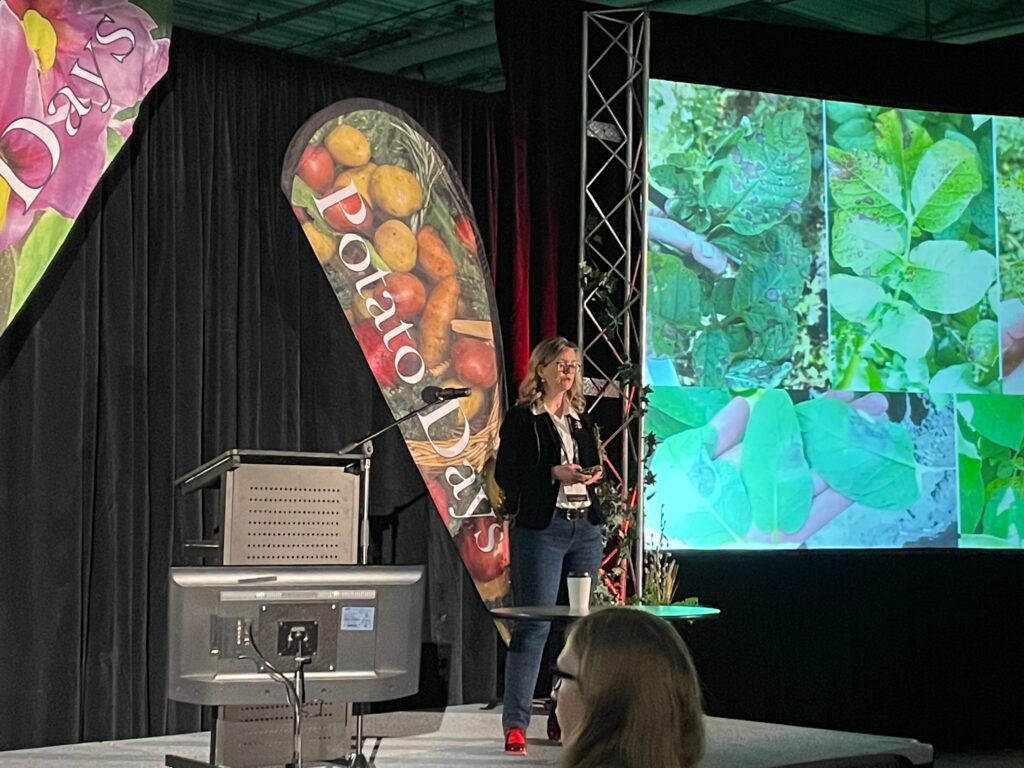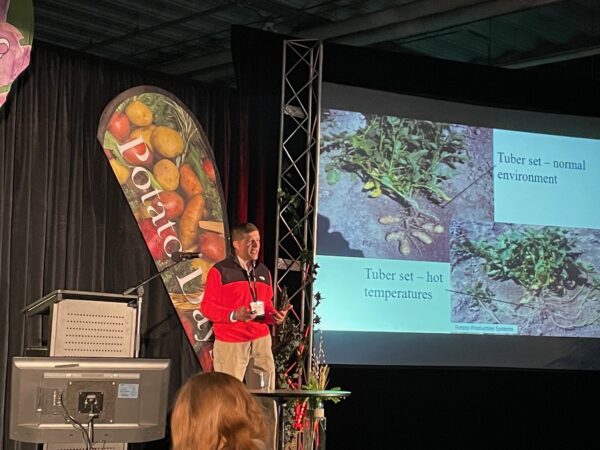
Features
Crop Protection
Diseases
Environment
Pest Control
Manitoba Potato Production Days kicks off in Brandon
January 25, 2023 By Derek Clouthier
 Tracy Shinners-Carnelley, vice-president of research, quality and sustainability at Peak of the Market. Photo by Derek Clouthier
Tracy Shinners-Carnelley, vice-president of research, quality and sustainability at Peak of the Market. Photo by Derek ClouthierManitoba Potato Production Days marked its 50th anniversary with its annual trade show and conference Jan. 24-26, diving into a myriad of topics on the first full day ranging from an update on pesticide use and ESG (Environment, Social, Governance) trends to the impact extreme heat has on crop production.
On the pesticide front, Tracy Shinners-Carnelley, vice-president of research, quality and sustainability at Peak of the Market, says Canada’s Pest Management Regulatory Agency (PMRA) recently conducted a re-evaluation of Group M fungicides over the past few years, which included such ingredients as Chlorothalonil, Mancozeb, Metiram and Captan. Shinners-Carnelley says these ingredients “are the backbone of disease management” in potatoes, providing resistance management and broad-spectrum protection while being a cost-effective option.
Mancozeb experienced a recent change on the potato side because of the re-evaluation. Seed-piece treatments are no longer supported by the manufacturer and usage is restricted to a maximum of eight foliar applications. Re-entry intervals were also set to .5 days and pre-harvest intervals to three days. The deadline to implement these label changes was Nov. 19, 2022 and will take effect for the 2023 growing season.
Though Chlorothalonil was re-evaluated in 2018, there was an updated special review in 2022 focusing on dietary and environmental risk. As a result, PMRA’s proposed decision is to maintain the ingredient’s use on greenhouse ornamentals, but cancel all other uses, including for potatoes.
The PMRA reviews pesticides every 15 years to ensure they remain safe for use and can conduct special reviews if there are reasonable grounds of a risk.
Turning up the heat
Extremely hot weather can also pose a risk to potatoes, as Mike Thornton, professor of plant science from the University of Idaho, points out.
Using his home state as an example, Thornton showed how 2021 was a challenging year for potato farmers in his area. In Aberdeen, Idaho, temperatures were 15 per cent higher during growing days, with 43 days over 32 degrees Celsius, 15 over 35 and three with mercury levels above 38.
“Is the heat hurting the potato or helping the potato?” Thornton questions, concluding, “It’s not that simple.”

Mike Thornton, professor of plant science from the University of Idaho.
Thornton says several factors influence whether extreme heat will have a negative impact on potato crops, including timing of the heat – early in the growing season during tuberization has a more significant impact – and water/irrigation practices.
Thornton advises potato farmers to employ good practices, such as the 4Rs (right source, right rate, right time, right place) and N2O management, as well as monitoring weather patterns to ensure proper watering.
The optimal temperature for potato production is 25 degrees Celsius during the day and 12 at night. Ten days of high temperatures can have a significant impact on potato production.
Manitoba Potato Production Days continues Jan. 26 with speakers discussing the impact of wildfires smoke on production, soil health and regenerative agriculture practices.
Print this page